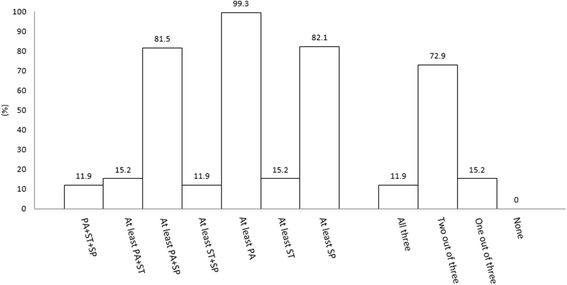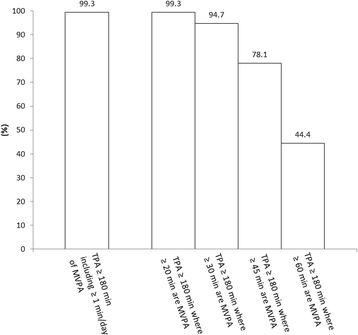Meeting new Canadian 24-Hour Movement Guidelines for the Early Years and associations with adiposity among toddlers living in Edmonton, Canada
- PMID: 29219096
- PMCID: PMC5773869
- DOI: 10.1186/s12889-017-4855-x
Meeting new Canadian 24-Hour Movement Guidelines for the Early Years and associations with adiposity among toddlers living in Edmonton, Canada
Abstract
Background: Canada has recently released guidelines that include toddler-specific recommendations for physical activity, screen-based sedentary behaviour, and sleep. This study examined the proportions of toddlers meeting the new Canadian 24-Hour Movement Guidelines for the Early Years (0-4 years) and associations with body mass index (BMI) z-scores in a sample from Edmonton, Canada.
Methods: Participants included 151 toddlers (aged 19.0 ± 1.9 months) for whom there was complete objectively measured physical activity data from the Parents' Role in Establishing healthy Physical activity and Sedentary behaviour habits (PREPS) project. Toddlers' physical activity was measured using ActiGraph wGT3X-BT monitors. Toddlers' screen time and sleep were measured using the PREPS questionnaire. Toddlers' height and weight were objectively measured by public health nurses and BMI z-scores were calculated using World Health Organization growth standards. Meeting the overall 24-Hour Movement Guidelines was defined as: ≥180 min/day of total physical activity, including ≥1 min/day of moderate- to vigorous-intensity physical activity; no screen time per day (for those aged 12-23 months) or ≤1 h/day of screen time per day (ages 24-35 months); and 11-14 h of sleep per 24-h period. Frequency analyses and linear regression models were conducted.
Results: Only 11.9% of toddlers met the overall 24-Hour Movement Guidelines, but this finding was largely driven by screen time. The majority of toddlers met the individual physical activity (99.3%) and sleep (82.1%) recommendations, while only 15.2% of toddlers met the screen time recommendation. No associations were observed between meeting specific and general combinations of recommendations within the guidelines and BMI z-scores.
Conclusions: Most toddlers in this sample were meeting physical activity and sleep recommendations but were engaging in more screen time than recommended. Consequently, only a small proportion of toddlers met the overall guidelines. Based on the findings of this study, identifying modifiable correlates of screen time to inform appropriate strategies to reduce screen time appears key for increasing the proportion of toddlers meeting the 24-Hour Movement Guidelines for the Early Years. Future research should examine the associations between meeting the new guidelines and other health indicators. Furthermore, future high-quality studies examining dose-response relationships between movement behaviours and health indicators are needed to inform guideline updates.
Keywords: Body mass index; Guidelines; Physical activity; Sedentary behaviour; Sleep; Toddlers.
Conflict of interest statement
Ethics approval and consent to participate
Ethics approval was obtained from the University of Alberta Human Research Ethics Board, and all participating parents provided written informed consent.
Consent for publication
Not applicable.
Competing interests
The authors declare that they have no competing interests.
Publisher’s Note
Springer Nature remains neutral with regard to jurisdictional claims in published maps and institutional affiliations.
Figures


References
MeSH terms
LinkOut - more resources
Full Text Sources
Other Literature Sources
Medical
Miscellaneous

